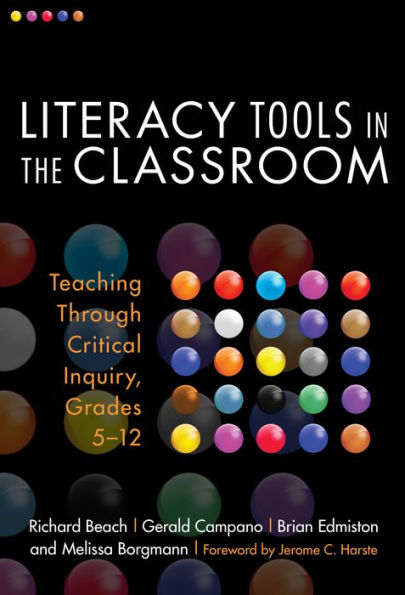This innovative resource describes how teachers can help students employ “literacy tools” across the curriculum to foster learning. The authors demonstrate how literacy tools such as narratives, question-asking, spoken-word poetry, drama, writing, digital communication, images, and video encourage critical inquiry in the 5–12 classroom. This dynamic text will inspire teachers to:
- Work together to create richer and more equitable literacy curricula.
- Develop purpose-driven activities and projects.
- Identify and showcase students’ strengths through their use of literacy tools.
- Foster learning and critical inquiry across the content areas.
- Use “change-based assessment” to encourage student reflection and growth.
Richard Beach is professor of English education at the University of Minnesota. Gerald Campano is an assistant professor at Indiana University, Bloomington. Brian Edmiston is associate professor of teaching and learning at The Ohio State University. Melissa Borgmann has worked as a high school English teacher, a literacy coach, a K–12 teaching artist, and as director of “The Juno Collective,” which centers on literacy through the arts.
“This book is a well-thought-out answer to the question I am constantly asked by teachers, ‘What does critical literacy mean in terms of what I might consider doing differently in my classroom?’”
—From the Foreword by Jerome C. Harste, Professor Emeritus, Indiana University, Bloomington.
“A unique blend of digital literacy tools with traditional forms. Literacy Tools in the Classroom ushers us into a 21st-century vision of literacy education—a fine and flexible view—through compelling narratives of educational possibility.”
—Shelby A. Wolf, University of Colorado at Boulder, author of Interpreting Literature with Children
“The promise of this book reflects the dedication of youth and adults to collaborate for change and imagine the expansive possibilities of multimodal communicative forms in their ongoing search for increased understandings of self across multiple spaces.”
—Valerie Kinloch, School of Teaching and Learning, The Ohio State University, author of Harlem on Our Minds
This innovative resource describes how teachers can help students employ “literacy tools” across the curriculum to foster learning. The authors demonstrate how literacy tools such as narratives, question-asking, spoken-word poetry, drama, writing, digital communication, images, and video encourage critical inquiry in the 5–12 classroom. This dynamic text will inspire teachers to:
- Work together to create richer and more equitable literacy curricula.
- Develop purpose-driven activities and projects.
- Identify and showcase students’ strengths through their use of literacy tools.
- Foster learning and critical inquiry across the content areas.
- Use “change-based assessment” to encourage student reflection and growth.
Richard Beach is professor of English education at the University of Minnesota. Gerald Campano is an assistant professor at Indiana University, Bloomington. Brian Edmiston is associate professor of teaching and learning at The Ohio State University. Melissa Borgmann has worked as a high school English teacher, a literacy coach, a K–12 teaching artist, and as director of “The Juno Collective,” which centers on literacy through the arts.
“This book is a well-thought-out answer to the question I am constantly asked by teachers, ‘What does critical literacy mean in terms of what I might consider doing differently in my classroom?’”
—From the Foreword by Jerome C. Harste, Professor Emeritus, Indiana University, Bloomington.
“A unique blend of digital literacy tools with traditional forms. Literacy Tools in the Classroom ushers us into a 21st-century vision of literacy education—a fine and flexible view—through compelling narratives of educational possibility.”
—Shelby A. Wolf, University of Colorado at Boulder, author of Interpreting Literature with Children
“The promise of this book reflects the dedication of youth and adults to collaborate for change and imagine the expansive possibilities of multimodal communicative forms in their ongoing search for increased understandings of self across multiple spaces.”
—Valerie Kinloch, School of Teaching and Learning, The Ohio State University, author of Harlem on Our Minds

Literacy Tools in the Classroom: Teaching Through Critical Inquiry, Grades 5-12

Literacy Tools in the Classroom: Teaching Through Critical Inquiry, Grades 5-12
eBook
Related collections and offers

Product Details
| ISBN-13: | 9780807770641 |
|---|---|
| Publisher: | Teachers College Press |
| Publication date: | 03/11/2014 |
| Series: | Language and Literacy Series |
| Sold by: | Barnes & Noble |
| Format: | eBook |
| Sales rank: | 891,180 |
| File size: | 321 KB |
